
Wednesday, March 31, 2010
CPotD #75 (Wacky Wednesdays)

Ah Harbor Freight, Your Treasures are Irresistible
I was out this morning getting my license renewed, and even though I entered another time dimension when walking through their front door, my MVA experience only lasted an amazingly prompt twenty minutes. Understand that twenty minutes in Earth time is only seven minutes in MVA time, so having my mug electronically captured (I went for the smirk rather than the smile this time), eyes checked (yes, I still need glasses), address verified (like I could have found someone to buy my house), and organs dedicated (what will be left of them) in such a short period must have been a record.
But I digress. Since my ordeal had not been epic, I felt I had time to go two blocks down the street to the frugal mechanic’s favorite emporium of all tools Chinese. Harbor Freight, like the MVA has its own time dimension, but unfortunately time speeds up rather than slows down. A simple, quick stop for a single item always turns into a slow walk though every aisle to make sure I don’t miss that vital doo-dad or gizmo that they are just about giving away that day. So, even though the Safety Equipment aisle with the face shield I needed was right inside their front door, I could not resist walking round the store snagging essential articles until my arms were full. After an extra thirty-five dollars and fifteen more minutes, I finally escaped. I got exceptional deals on a couple flap wheels (for grinding down welds) and two hose hangers (better than big, loose nails for storing air hoses), decent deals on a package of ten cutoff wheels (all this sheetmetal work has got me running low), a bag of earplugs (so Victoria doesn’t have to share my earwax), and some butt weld clamps (no more wavy welds), and an okay deal on a tarp (now whichever project’s been relegated to the driveway will be somewhat protected).
Oh yeah, I did remember the face shield.
Tuesday, March 30, 2010
CPotD #74 (Track Car Tuesdays)
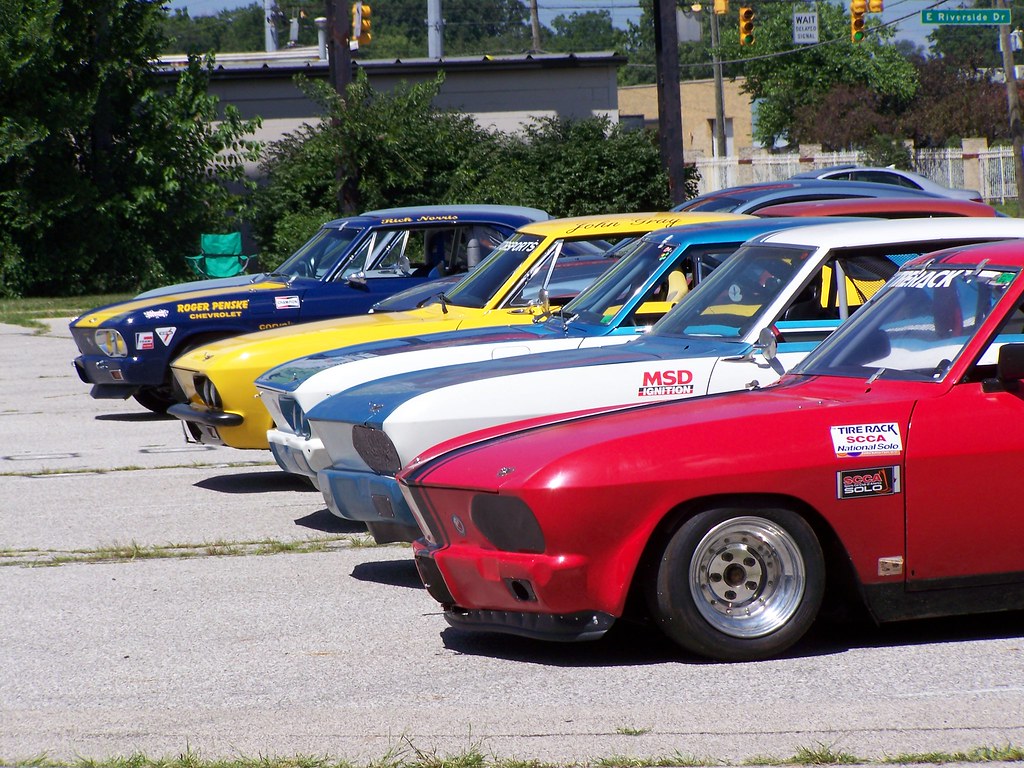
Monday, March 29, 2010
CPotD #73 (Corvairs, In Europe?)
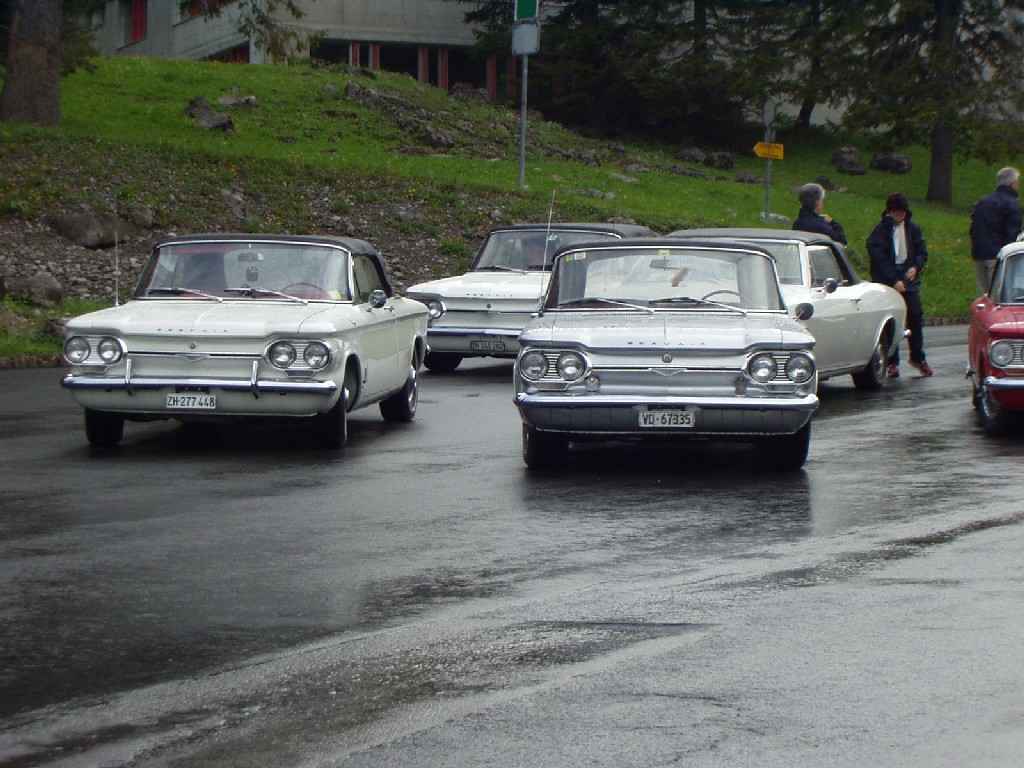
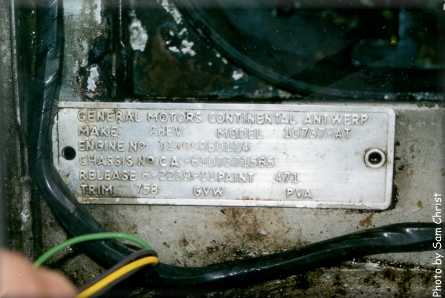 occasion at which this photo was snapped, but the odd license plates are the evidence it was in Europe, and the file name leads me to believe it was a Swiss Corvair Club event. Also, here’s a photo of a VIN plate listing Antwerp, Belgium as the country of origin. According to Kent Sullivan's article, Switzerland was a second country of origin. Kent goes on to describe how the GM assembly plant would gather all the sub-assemblies and parts necessary to build a car, crate them up, and ship them to another GM plant for final assembly. These crates of parts were known as “Completely Knocked-Down” units.
occasion at which this photo was snapped, but the odd license plates are the evidence it was in Europe, and the file name leads me to believe it was a Swiss Corvair Club event. Also, here’s a photo of a VIN plate listing Antwerp, Belgium as the country of origin. According to Kent Sullivan's article, Switzerland was a second country of origin. Kent goes on to describe how the GM assembly plant would gather all the sub-assemblies and parts necessary to build a car, crate them up, and ship them to another GM plant for final assembly. These crates of parts were known as “Completely Knocked-Down” units.A Nice Fitch Phoenix Article
Confirmation
This latter discovery came when we removed the passenger door to give us better access cutting off the rear portion of the right front fender. Prior to unbolting the hinges, we drilled two small holes through the hinges and into the body panel. If I don’t use the door on New Betty, I’ll reinstall it to get it out of the way and the holes will make the process go quicker.
Victoria also put down some more Bondo on Glinda to smooth out some rough places around the windshield and backlight. She’s getting good at laying down the filler – practice makes perfect.
After stops at Home Depot (grommet) and Pep Boys (coupler and synthetic brake fluid), I now have all the pieces required to finish Lucy’s master cylinder swap. I still need to overcome the time and space factors of my TTT (see sidebar). With a wet weather forecast for the next couple of days and the garage filled, space can only be overcome by pushing Old Betty out into the elements. Not fun to do in the rain.
Friday, March 26, 2010
CPotD #72 (Speedy Spyder Successor)
The Clunk’s From Somewhere
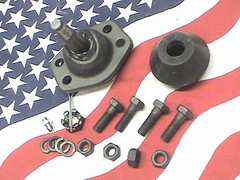 The last week or so I’ve noticed a clunk sound coming from the right front wheel area when going over bumps. The other night, when I was lubing the front suspension, I couldn’t find any looseness. Last night, however, I pushed and pulled on the right front wheel and could feel a little slop. I’m guessing it’s the upper balljoint since the lower one was replaced only a year ago. Finding which part it is will require two people – one to lie on their back staring at balljoints and the other to push and pull on the wheel. Oh Victoria? I really need to get to the bottom of this and get the failing part replaced soon. The NECC tech inspector will not allow any suspension slop, and I don’t want to get to the track only to be rejected at inspection.
The last week or so I’ve noticed a clunk sound coming from the right front wheel area when going over bumps. The other night, when I was lubing the front suspension, I couldn’t find any looseness. Last night, however, I pushed and pulled on the right front wheel and could feel a little slop. I’m guessing it’s the upper balljoint since the lower one was replaced only a year ago. Finding which part it is will require two people – one to lie on their back staring at balljoints and the other to push and pull on the wheel. Oh Victoria? I really need to get to the bottom of this and get the failing part replaced soon. The NECC tech inspector will not allow any suspension slop, and I don’t want to get to the track only to be rejected at inspection.
Thursday, March 25, 2010
CPotD #71 (The Heart of a Spyder)
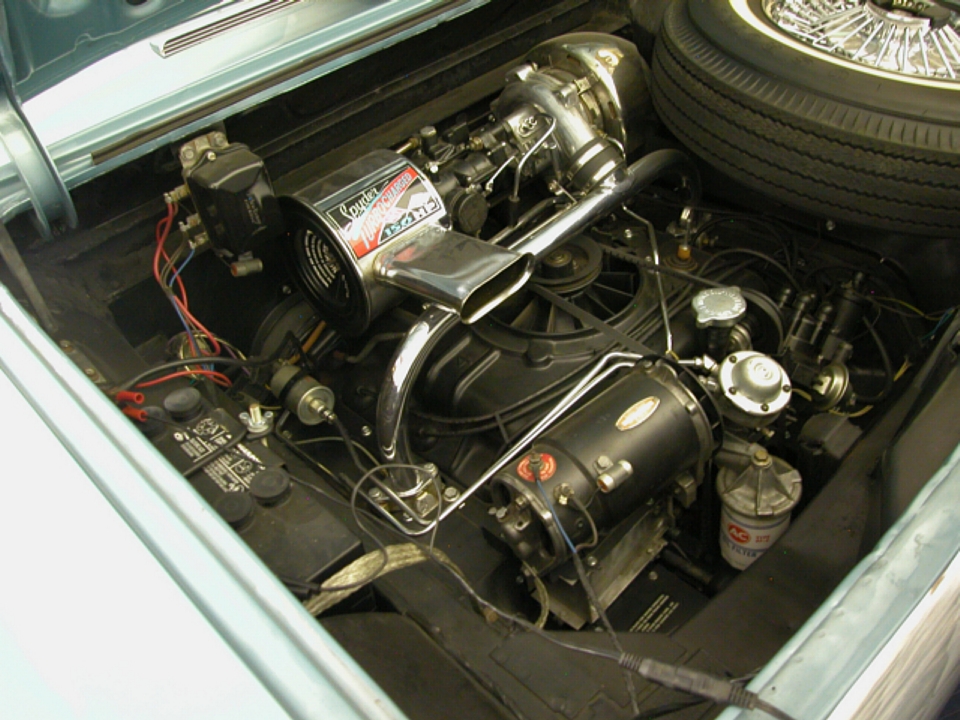
In reading books, articles and postings on Virtual Vairs and the CorvairCenter forum about Spyder engines, I’ve learned some interesting differences from the standard engines. I’m doing this off the top of my head, so I may not have all my facts straight.
- The carburetor was a single-barrel side-draft unit with the flow-rate sized to control the boost from the turbocharger.
- The exhaust pipe path necessitated a cutout at the rear of the car for the tailpipe.
- The crankshaft is nitrided to improve strength and reliability.
- The compression ratio is lower to allow the engine to run on the pump gas that was available in the 60s.
- The distributor was controlled by a vacuum unit that retarded the timing instead of advancing it at higher vacuum (lower loads).
- The dash is special with additional gages for boost and cylinder head temperature.
- The front anti-roll bar and heavy-duty springs were standard.
- The engine was only available in a 2-dr coupe or convertible.
I’m sure there are many more factoids of uniqueness, but these are the ones that I was able to pluck from my stubborn memory.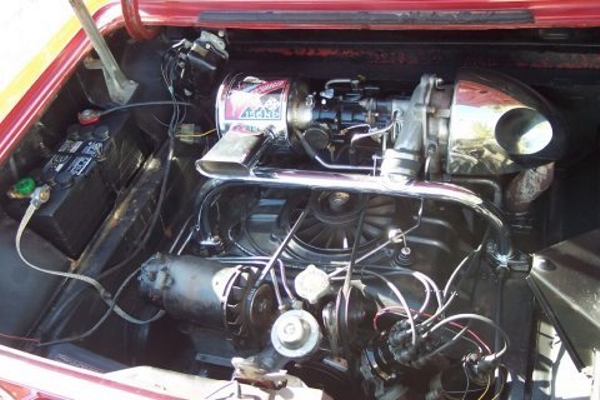

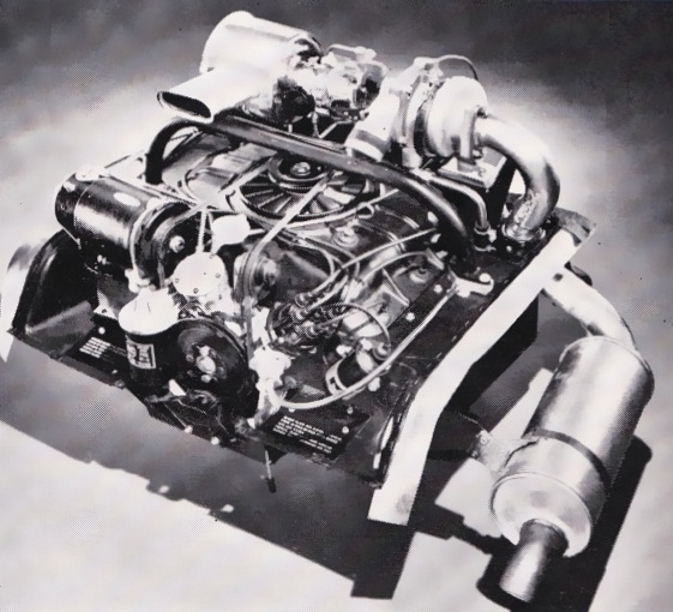
Crossing Things Off
 the front valence. Something’s got to be done there and soon. I’m running out of good metal to weld to. I haven’t decided how I’m going to recreate the grooves that were stamped into the curved shape. Those grooves are shown in the photo at left of Heidi without paint. I’m thinking I’ll have to form the grooves with the sheetmetal in the flat, and then form the overall curved shape. Unfortunately, that goes against the whole premise of having the grooves stiffen the curved shape. Oh well, us shadetree mechanics gotta’ do what we gotta’ do.
the front valence. Something’s got to be done there and soon. I’m running out of good metal to weld to. I haven’t decided how I’m going to recreate the grooves that were stamped into the curved shape. Those grooves are shown in the photo at left of Heidi without paint. I’m thinking I’ll have to form the grooves with the sheetmetal in the flat, and then form the overall curved shape. Unfortunately, that goes against the whole premise of having the grooves stiffen the curved shape. Oh well, us shadetree mechanics gotta’ do what we gotta’ do.Wednesday, March 24, 2010
CPotD #70 (Spied a Spyder)
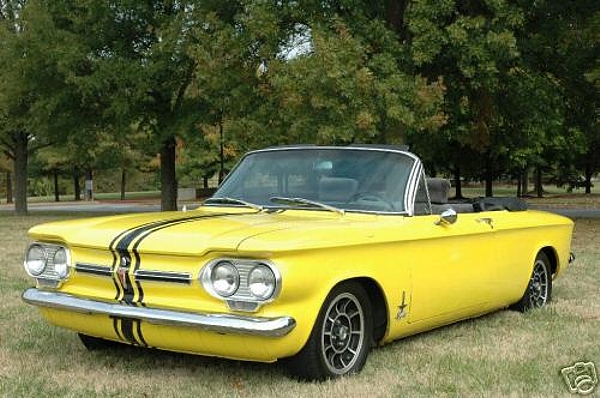
I thought there’d be a ton of Spyder history links I would have to choose from to put in this post, but I was sorely mistaken. After a little searching, I found an online version of the April 1962 Popular Science review. Click here to be sent to that page.
In my formative years, I made my first contact with a Spyder. When I was in high school I spent a few weeks working at a church in SE Washington state. One of the evenings was spent at the home of a congregant where an abandoned Spyder was parked under a tree. I had never seen one of these interesting little cars before, and was thoroughly intrigued by the chrome shapes under the hood. The air cleaner and heat shield made this engine compartment look significantly different than anything I’d ever worked on. My dad drove a ’68 VW micro-bus, so the engine in the rear wasn’t a shock, but that turbo was something else.
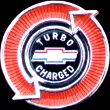 I didn’t think much about Spyders after that, and don’t remember ever noticing one for that matter, until five or six years later. My first post-college employer was located in an old, converted high school, so it sat in the middle of a rather larger residential area of Sunnyvale, CA. Weather-permitting, my daily lunch-hour was spent walking the streets around the neighborhood. As I was passing through the parking lot one day, I spied a Corvair convertible with the oversized spinning arrows emblem on the engine lid. This was in 1985, so the car was a little over twenty years old at the time, and appeared to be someone’s daily driver.
I didn’t think much about Spyders after that, and don’t remember ever noticing one for that matter, until five or six years later. My first post-college employer was located in an old, converted high school, so it sat in the middle of a rather larger residential area of Sunnyvale, CA. Weather-permitting, my daily lunch-hour was spent walking the streets around the neighborhood. As I was passing through the parking lot one day, I spied a Corvair convertible with the oversized spinning arrows emblem on the engine lid. This was in 1985, so the car was a little over twenty years old at the time, and appeared to be someone’s daily driver.Another “Ran When Parked”
The seller had a nice story about how he used to drive it frequently and parked it on the street, but then the top got a hole cut into it by some vandal, so he moved it up into the driveway where it was only driven on nice days. A few years later, he found that he didn’t drive it at all anymore and that now it would not start. With health issues, his wife convinced him it was time to put it up for sale.
Since I already have a relatively rust-free convertible patiently awaiting my attention (a Pontiac), I truly had no business even entertaining the thought of acquiring this one, but I justified the gas by being able to tell others that, if they have the skills, it’s a pretty good deal. Much, much better than the $2200 ‘vert also for sale near me.
Tuesday, March 23, 2010
CPotD #69 (Lucy at Speed)
Lucy and I running at BeaveRun last fall is today’s CPotD. It’s especially relevant since I just registered for the next NECC time trial event. The awesome, hi-res photo was taken by the wife of one of the racers and is posted on NECC’s website.
This one’s right in my backyard at Summit Point Raceway’s Main Circuit on May 3rd, so I won’t have to burn money on hotel and restaurant - a VERY good thing indeed.
Needless to say I am excited. With new tires since the last time I was on a track, I expect a significant improvement in cornering ability. To get myself prepared, I’ve started memorizing the course using an online turn-by-turn guide and an in-car video. Lucy is already pretty much prepared. Okay, I guess that hinges on your definition of “pretty much.” I still need to change the oil and filter, lube the front suspension, clean and repack the front wheel bearings, rotate the tires, complete the master cylinder swap, purge the brake lines and re-fill with synthetic brake fluid, check the condition of the brake shoes, and re-install the harness in the front passenger seat. I’d also really like to get the front valence patched and maybe cut a coil out of each rear spring. Hmm, “pretty much” is beginning to sound more like “no where close to.”
Monday, March 22, 2010
Ringo: The Report of his Death was an Exaggeration
I left the house around six with the Suburban packed with three fuel pumps (two used ones from the shelf and the good one out of Lucy), a bag-full of tools, and all the equipment required to flat-tow a Corvair. After picking up Ariel and eating a delicious, enjoyable meal together, we drove to the Lancaster K-mart parking lot - Ringo’s resting place. I was all ready to jump into replacing the fuel pump and had his engine lid when Ariel calmly suggested she try and start him first. A twist of the key and a little blipping of the throttle and he was running like he didn’t have a care in the world. Ariel felt badly for having me drive all that way for nothing. I assured her I thoroughly enjoyed our time together, and I didn’t blame her for any of it. Who would have known that she had been only one crank shy of starting him Saturday?
So, I gave her instructions on how to deal with vapor lock-sensitive car, “Don’t expect him to start if he’s sat for more than a few minutes and less than a couple hours.” I went on to promise her I’d get towing service added to the insurance policy in case it happens again in a less convenient, and that next time she was home, I’d do all I could to ensure he wasn’t so sensitive.
She then drove Ringo off into the night to return to her dorm.
CPotD #68 (LMs Take Over)
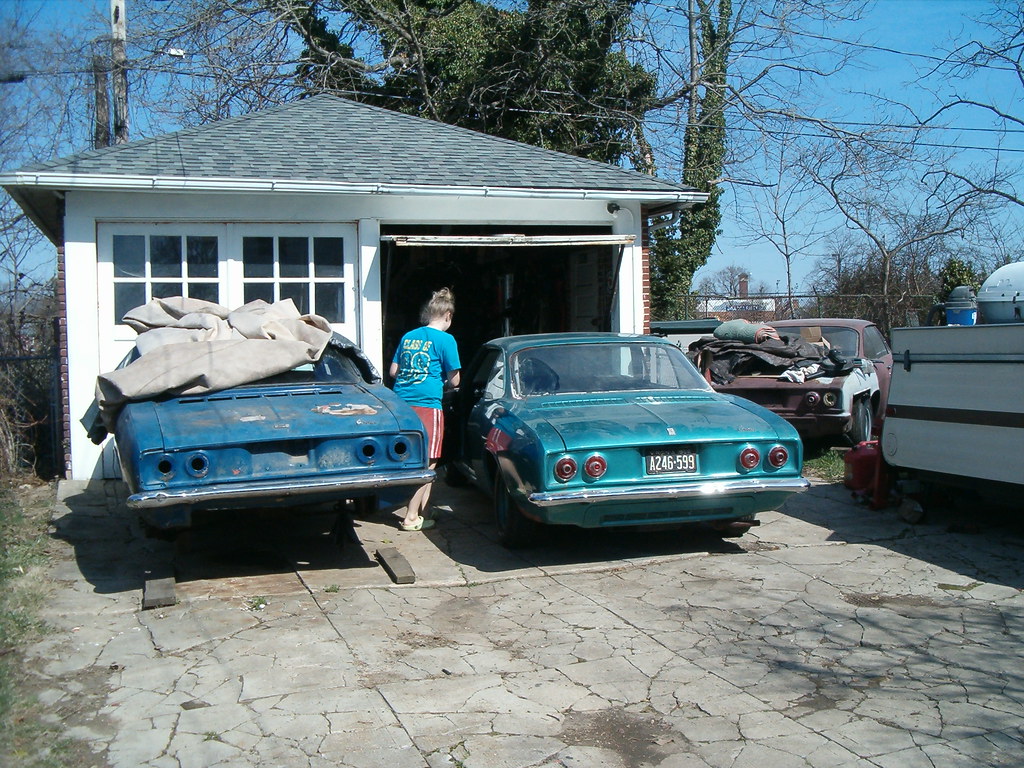
Saturday's beginning sucked, but it soon got MUCH better. I got up too early for a weekend morning so I could be prepared for the nine AM CORSA of Baltimore meeting start. I packed the tools I thought I’d need to do a brake master cylinder (MC) swap on Lucy. Then it was off to Carquest to pick up the new dual MC I’d ordered the night before. There was a problem. The part hadn’t arrived. I was pissed since this is the second time they’ve screwed up like this. After getting my money refunded, I headed down the road to Pep Boys where, lo and behold, they had the MC on the shelf and it was cheaper. I spent too long on their brass fittings' aisle trying to find all the adapters, plugs, and couplings required to complete the job and came up empty.
I left there with the MC and headed to CORSA of Baltimore’s first meeting of the year. Arriving late, the driveway was already pretty crowded. The host’s five Corvairs in the driveway primed the pump, so to speak, for a ‘vair-filled, sun-drenched morning. At one point, there were twelve of GM’s finest sitting in front of Rich’s house.
I told my story of woe regarding my MC parts hunt, and Rich offered me a complete conversion kit from Clark’s he had sitting on a shelf. I pulled the pertinent parts from the box and made a quick and fruitful visit to NAPA. Then, after removing the old single-reservoir MC and brake line and bolting in the new dual MC, I used Rich’s tube bender to form the new lines. Even with all the parts, the late start prevented me from finishing the project, so I had to reinstall the original MC and bleed the system at the MC so I could safely drive home.
By the time I got home, it was after one and too late to head to Millersville to deal with dead Ringo. Instead I called Ariel to tell her of the change in plans, and asked her to please have someone give her a ride to Ringo and try to get him to start one more time. Then I had Victoria change her clothes and she and I moved cars around until Glinda was on the ground and ready to roll. What followed was a very morale-boosting experience for both of us. She actually drove her car through the neighborhood and to the gas station. Other than some serious pinging due to the old, old gas, Glinda ran like a champ.
Today’s CPotD was taken soon after our return. Compare that photo to the following one taken a few years ago, and you’ll see the focus of the roadification portion of fleet management has changed from EMs to LMs.
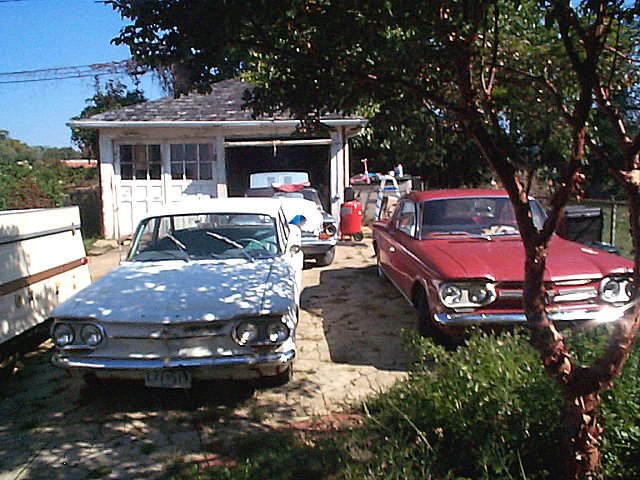
After that excitement, we put Glinda and Old Betty back in the garage and I handed Victoria the grinder and had her start cutting off some more body panels from Old Betty.
The Corvair portion of the day ended when Ariel called and told me she had tried starting Ringo a few times and he just wouldn’t catch. I told her I’d be there the next day.
Friday, March 19, 2010
CPotD #67 (The Whale Revisited)
Thursday, March 18, 2010
Ringo’s to be Rescued and Refurbed
Tomorrow morning early I will drive the Suburban to work with the towing equipment (hitch, tow-bar, strap, and light set) in the back. Around two I’ll depart for Millersville to drag the antagonistic automobile home where he will remain until he has been made one hundred percent reliable. What does that mean? How about the following:
- Drop the engine and rebuild with new cylinders, piston assemblies, rings, and rod bearings. This will stop the blow-by that’s been continuously pumping oil into the air cleaner fouling the carburetors and plugs and causing poor idling. This will also mean the end of constantly checking the oil level and adding a quart every fifty miles or so.
- Install a replacement torque converter with a good ring gear. This will ensure the starter engages EVERY time, not every other time like it does currently.
- Clean out and re-seal all seams I can get to. This will keep the carpet dry.
- Remove and reinstall the rear window with a new seal and better technique. This WILL stop the constant leaking that’s rusting out the floor under the rear seat.
- Cut out the rusted metal under the rear seat and weld in replacement patches. Coat everything with Rustoleum and/or POR-15.
When I’m done, Ariel can expect to find Ringo roadworthy fifty years from now. Lucky her ;-)
Now I have no idea how I'll squeeze in these tasks. If ever my Triumvirate of Tribulation (see sidebar) was more evident, I certainly don't remember.
CPotD #66 (Let's Get Military)

 was taken on a highway in Vietnam. The stock engine was modified to fit the different engine bay and drive the different transaxle. There are lots of photos and information at this thread on the CorvairCenter forum and on this page about Canadair vehicles and this excellent page on the origin of the vehicle.
was taken on a highway in Vietnam. The stock engine was modified to fit the different engine bay and drive the different transaxle. There are lots of photos and information at this thread on the CorvairCenter forum and on this page about Canadair vehicles and this excellent page on the origin of the vehicle.Wednesday, March 17, 2010
CPotD #65 (Dune Buggy's are Boss)
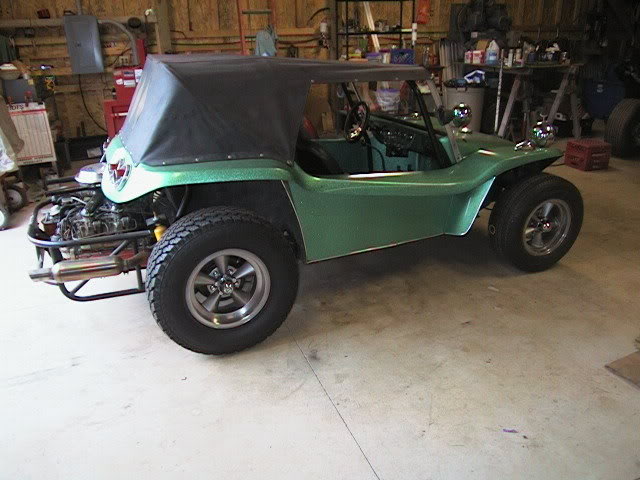
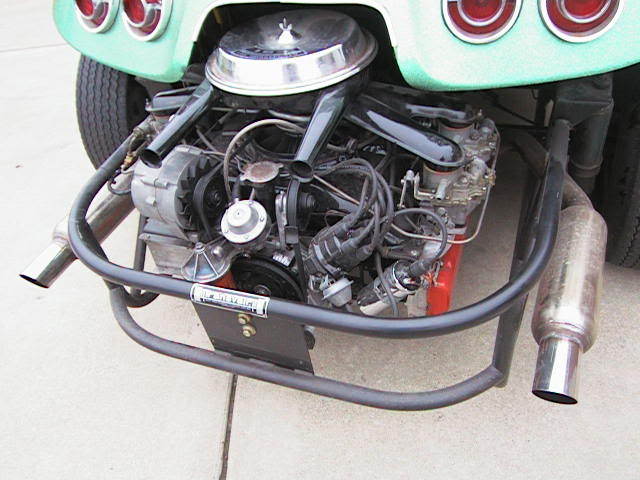 I’m sure this one was, like the majority of dune buggies, Volkswagen powered. There were, however, a number of folks who transplanted the Corvair engine into their dune buggy for more power. Today’s CPotD is of one of those hot, little numbers.
I’m sure this one was, like the majority of dune buggies, Volkswagen powered. There were, however, a number of folks who transplanted the Corvair engine into their dune buggy for more power. Today’s CPotD is of one of those hot, little numbers.Vapor Lock or Something Else
If it is vapor lock, then why did it just start? Could it be the fuel pump is now bad explaining why it won’t start today even after sitting for over an hour by now?
Ariel does not want the car back unless it is absolutely reliable. How do I guarantee that on a nearly fifty year-old vehicle? Ah, the frustrations of Corvair Fleet Management.
Tuesday, March 16, 2010
CPotD #64 (Fitch's Phoenix)
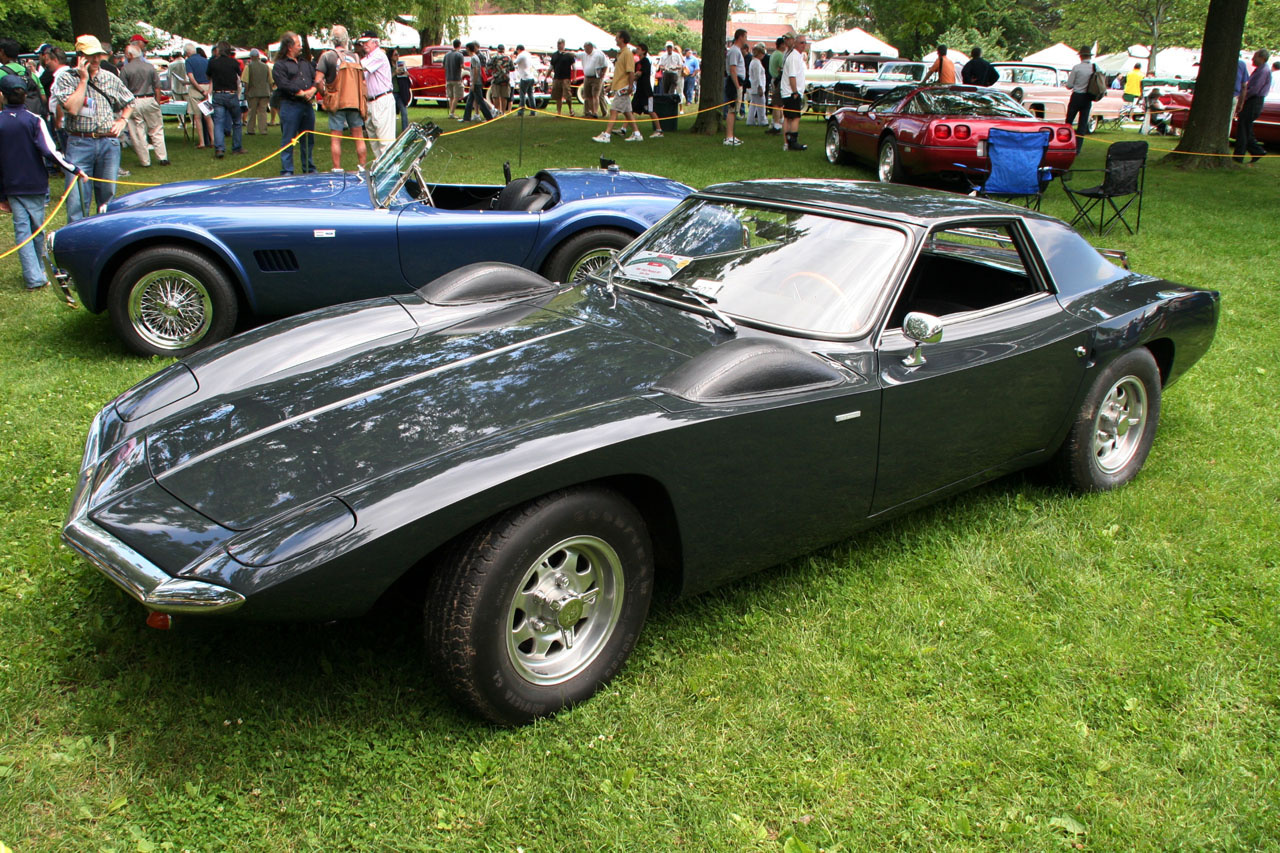
Today’s CPotD shows a car designed and produced by a man whose most-seen invention sits on major interstates across the nation. The yellow, plastic, sand-filled barrels placed in front of fixed structures were designed and developed by John Fitch. He was an inventor and innovator with a background in auto racing. There are many sites on the web detailing his life and accomplishments; this Wikipedia page being one of them.
When GM came out with the Corvair, he saw the potential for it to be a track-worthy car. Initially, Fitch modified stock Corvairs calling them Sprints. Later, he designed and built a two-seat sports-car using the LM Corvair as the basis. The car in the foreground of today’s photo is the Phoenix prototype. The image was shot at the 2009 Greenwich Concours d’Elegance in Connecticut and posted on Autoblog’s website.
Monday, March 15, 2010
CPotD #63 (Corvair-based Creations)

I’ve decided to move on from the orange-based CPotD theme (although I reserve the right to revisit) . Today’s photo initiates a short series of vehicles based on the Corvair drivetrain. A LM 140HP drivetrain provided motivation for this Piranha. More than one of these unique cars was made, and there are quite a few webpages devoted to its history. Here are a couple links.
Too Many Distractions
I believe it was sitting in front of the TV while eating lunch that doomed the day for garage time. I just couldn’t drag my butt out of the comfy, warm house and into the nasty, damp garage. I justified it by having to play chauffeur to Mikhaila at 2 o’clock – not enough time to make it worthwhile. Lame, lame, lame.
By dinner-time, the rain had abated, and at 8 o’clock it had stopped, so it was time to replace Ringo’s leaky packings. Even though I could only detect gas leaking from one of the ports, I replaced all six to be safe. I did notice, however, that the #5 gasket looked a little suspect, so that plan was a good one. That repair went well, and he was off the jackstands by 9:30.
Yesterday afternoon Ariel drove Ringo back to school. She got about a half-mile away when the new packings started smoking. I hadn’t used these kind before, so I had no idea to warn Ariel about the smell. She freaked out and immediately turned the car around and headed home. I assured her it was the hot, new gaskets, and told her the smell would go away in a few miles. It did, and she and Ringo made the 90 mile drive without any other incidence.
 I did go out to the garage yesterday afternoon. Since it was the most accessible area in need of work and the replacement panel on Old Betty seemed, I decided to start Glinda’s body work on her right rear fender. With the grinder’s wire brush wheel spinning at 11,000 rpm, it didn’t take long to be enveloped in a Bondo fog. It was a more extensive expedition than I’d hoped, but I finally found the end of the filler. Fortunately, Old Betty’s equivalent quarter-panel is nice and solid. I then turned my attention to Old Betty applying some masking tape to keep my hacking lines relatively straight. With a cut-off wheel replacing the brush wheel, the grinder got the panel about 98% cut off. The last two cuts had to be made with my little air hacksaw.
I did go out to the garage yesterday afternoon. Since it was the most accessible area in need of work and the replacement panel on Old Betty seemed, I decided to start Glinda’s body work on her right rear fender. With the grinder’s wire brush wheel spinning at 11,000 rpm, it didn’t take long to be enveloped in a Bondo fog. It was a more extensive expedition than I’d hoped, but I finally found the end of the filler. Fortunately, Old Betty’s equivalent quarter-panel is nice and solid. I then turned my attention to Old Betty applying some masking tape to keep my hacking lines relatively straight. With a cut-off wheel replacing the brush wheel, the grinder got the panel about 98% cut off. The last two cuts had to be made with my little air hacksaw.  I also needed to remove Old Betty’s rear bumper and exhaust system to access all around the panel. In removing the exhaust I discovered an interesting kludge. A previous owner had broken off the ears of the exhaust manifold where the exhaust pipe flanges are fastened. To provide a secure assembly, they used hose clamps to retain the bolts and nuts to the manifold. Ingenius.
I also needed to remove Old Betty’s rear bumper and exhaust system to access all around the panel. In removing the exhaust I discovered an interesting kludge. A previous owner had broken off the ears of the exhaust manifold where the exhaust pipe flanges are fastened. To provide a secure assembly, they used hose clamps to retain the bolts and nuts to the manifold. Ingenius.
Friday, March 12, 2010
CPotD #62 (Orange Makes Even an FC Look Awesome)

Exhaust and Exhausting
The next portion of the evening was pushing Old Betty and New Betty around the driveway. I wanted to get Old Betty into the garage before the rain hit so she’d be accessible to cut patches off this wet weekend. It actually went easier than I’d expected, but was exhausting nonetheless.
Thursday, March 11, 2010
CPotD #61 (Don't Stare at the Sun)

Wednesday, March 10, 2010
CPotD #60 (They Make Orange EMs Too)
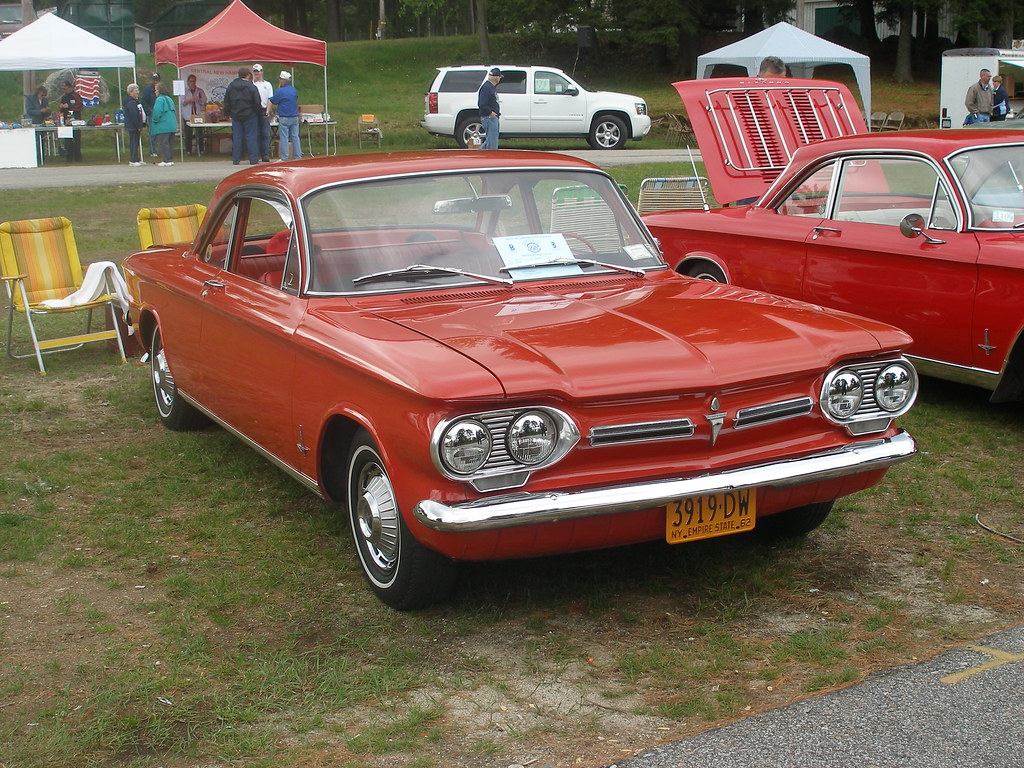
Good, Great, and Greater Still
The great is that I had time to turn the steering box setscrew hidden under the one inch diameter plug in the trunk. That got rid of the play in the steering wheel. How nice it is to turn the wheel and not have to take up five degrees of slop before feeling the front wheels respond.
Now for the greater still. This morning I received an e-mail from a ‘vair friend, Irv. Last Fall I loaned him one of my racing harnesses so he could participate in the NECC time trial event at Roebling Roads. Recently he acquired a collection of Corvairs and parts and offered them for sale to the Corvair community. I responded to his posting with a wish list that included a set of 140 horsepower heads and matching exhaust manifolds. His e-mail this morning said that he has them, is setting them aside for me, may deliver them to DC in two weeks, AND he’s giving me a “generous deal” to boot. I am so psyched.
An engine with the 140 HP heads installed looks like this:
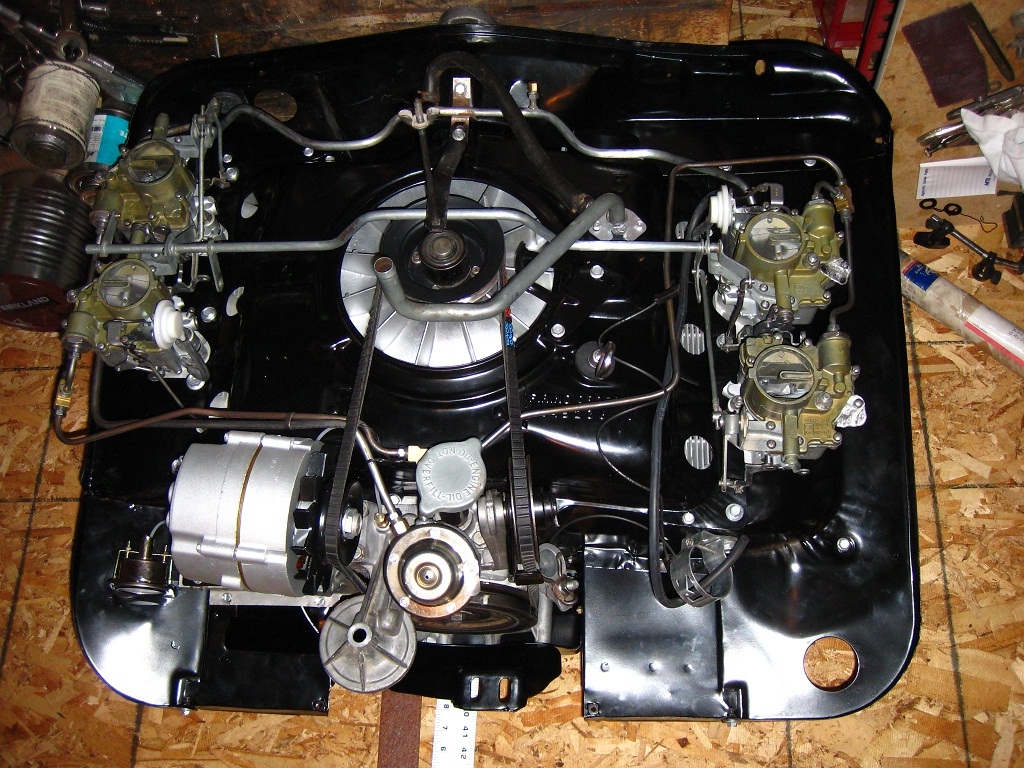 To accommodate the additional two carburetors (secondaries), I need to re-work the air cleaner, gas lines, and throttle linkage. Since I'm unwilling to spring for a stock air cleaner assembly, I'll end up clamping separate elements to the top of each carburetor with the PCV line plumbed into the base of the nearest element. The gas lines are pretty straightforward. I could give Clark’s Corvair Parts $60+, or I could make them myself from bendable brake lines or rubber fuel hoses. The throttle linkage needs to be progressive, which means the secondary carburetors don’t open until the primaries are roughly halfway to wide-open-throttle (WOT). The following close-up shows how this is accomplished.
To accommodate the additional two carburetors (secondaries), I need to re-work the air cleaner, gas lines, and throttle linkage. Since I'm unwilling to spring for a stock air cleaner assembly, I'll end up clamping separate elements to the top of each carburetor with the PCV line plumbed into the base of the nearest element. The gas lines are pretty straightforward. I could give Clark’s Corvair Parts $60+, or I could make them myself from bendable brake lines or rubber fuel hoses. The throttle linkage needs to be progressive, which means the secondary carburetors don’t open until the primaries are roughly halfway to wide-open-throttle (WOT). The following close-up shows how this is accomplished. The small rod to the secondary carburetor’s throttle (bottom one in the photo) doesn’t start moving until the actuator plate (circled in red) is rotated a pretty significant amount. Additionally, the throttle plate for the secondary carb is roughly half the length of the primary so that it opens faster with less rod input. This ensures that primary and secondary carbs reach WOT at the same time. I figure I can put together a mixture of extra linkage parts with homemade parts and replicate the functionality. After my successful engineering of the air cleaner spacers last weekend, I’m up for the challenge.
The small rod to the secondary carburetor’s throttle (bottom one in the photo) doesn’t start moving until the actuator plate (circled in red) is rotated a pretty significant amount. Additionally, the throttle plate for the secondary carb is roughly half the length of the primary so that it opens faster with less rod input. This ensures that primary and secondary carbs reach WOT at the same time. I figure I can put together a mixture of extra linkage parts with homemade parts and replicate the functionality. After my successful engineering of the air cleaner spacers last weekend, I’m up for the challenge.Oh yeah. Which car is getting this hot setup? I'm thinking Betty is the best candidate, but I'm not ruling out a quick intall in Lucy.
Tuesday, March 9, 2010
CPotD #59 (Fast Orange)
Oh Vapor Lock, We Know Thee Well
Now that we know the problem, we need to work the solution. I'll be installing an electric fuel pump before she goes back to school. The question is whether to make it a backup operated by a momentary switch or get rid of the mechanical pump. The latter would require the acquisition and installation of an inertia switch that would shut the pump off in case of a collision. A little more complicated. A little more research is in order before a decision is made.
Monday, March 8, 2010
CPotD #58 (Crazed 'Vair at Crazy Ray's)

Sunday Was Car Day
Next it was Lucy’s turn. She’s been so undemanding of my time, and I’ve greatly appreciated it. Lately, however, her gas mileage has been dropping, so I figured it was time for a tune-up. I installed the new points, condenser, rotor, and distributor cap parts I’d purchased from NAPA Friday. After setting the dwell and checking the timing, I moved on to the second project – checking out the clunking front end. I had been hearing a few clunking noises from her front steering the last few days. With the right front wheel jacked off the ground I found the wheel bearing had a tiny bit of play. I pulled the cotter pin and slightly tightened the nut before putting in a new pin. No more looseness and the wheel spun freely. Same situation on the other side. I’ll be paying attention to those bearings from now on. I don’t want to be rejected at inspection at the next NECC track event. Finally, I got to one of the improvement projects (as opposed to maintenance or repair) that’s been on my to-do list far too long. For many months I’ve been in possession of two plastic pipe couplers with the intention of using them to improve air flow into Lucy’s carburetors. Corvair stock air cleaners are low-profile forcing the incoming air to make a sharp turn right at the top of each carburetor. This results in the undesirable condition of turbulent air flow through the carburetor – not nearly as efficient as laminar flow. To allow the air flow to straighten before the carburetor, pipe couplers are inserted as spacers between the air cleaner outlets and the carb inlets. First task in the project was raising the support points for the air cleaner, and I accomplished this by cutting and installing two longer threaded rods with nuts and washers. Next I used hose clamps installed around the top of the carbs to keep each spacer centered over the venture. The final touch was zip-ties to keep the spacers snugly sandwiched in place. The final result is show in the following photos.
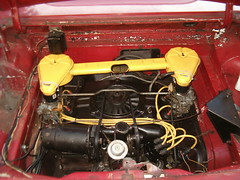
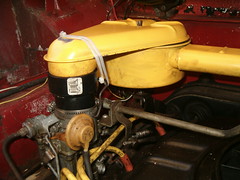 Victoria and I then spent some quality time together working on Glinda. We first removed the front air grill from its home at the base of the windshield. This gave us access to vaccum out leaves, rust, and other crud before prepping exposed metal for primer. Then Victoria had her first experience with Bondo as I showed her how to mix it and had her apply it to the rear window areas that we had previously de-rusted. I know, I know. I really should do this repair properly, but I’m not inspired enough to remove the backlight, cut out the pocked metal, and form and weld in replacement channel. Since we’re not planning on a total repaint, we’ll do the best we can with Bondo and spray paint and keep our fingers crossed surface bubbles don’t appear immediately. With the Bondo left to harden, we moved on to sanding the Rusty Metal primer she’d applied during our last outing together in the garage. That was it for the day.
Victoria and I then spent some quality time together working on Glinda. We first removed the front air grill from its home at the base of the windshield. This gave us access to vaccum out leaves, rust, and other crud before prepping exposed metal for primer. Then Victoria had her first experience with Bondo as I showed her how to mix it and had her apply it to the rear window areas that we had previously de-rusted. I know, I know. I really should do this repair properly, but I’m not inspired enough to remove the backlight, cut out the pocked metal, and form and weld in replacement channel. Since we’re not planning on a total repaint, we’ll do the best we can with Bondo and spray paint and keep our fingers crossed surface bubbles don’t appear immediately. With the Bondo left to harden, we moved on to sanding the Rusty Metal primer she’d applied during our last outing together in the garage. That was it for the day.
"It's a parts garden, not a junkyard."
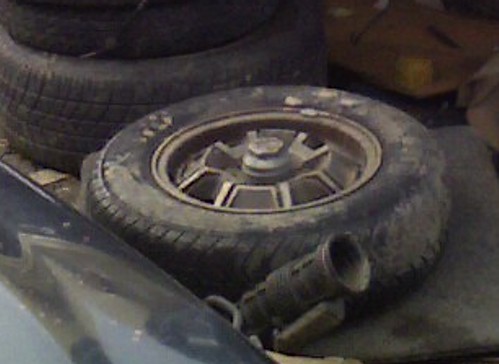 Friday was a good day to spend a little time wandering Crazy Ray’s rows of automotive rejects. I wanted to make sure no Corvairs had made their way into their inventory without being identified for possible parts pilfering (for a price of course). While no ‘vairs were spotted, I did find a few other photo-worthy oldies. I’ve posted them on one of my flickr sites. I was intrigued by the late-70s Corolla wheels. They’re probably fourteen inchers that would fit an EM.
Friday was a good day to spend a little time wandering Crazy Ray’s rows of automotive rejects. I wanted to make sure no Corvairs had made their way into their inventory without being identified for possible parts pilfering (for a price of course). While no ‘vairs were spotted, I did find a few other photo-worthy oldies. I’ve posted them on one of my flickr sites. I was intrigued by the late-70s Corolla wheels. They’re probably fourteen inchers that would fit an EM.
Friday, March 5, 2010
Prepping
Brianna and Nich are coming to spend this weekend with us, and with Nich’s car iffy they may need to drive Heidi up from Blacksburg. If Heidi does come up, I thought it would smart to grease the driver’s side rear wheel bearing to prevent a reoccurrence of this (click here). If that happens, I need to get New Betty out of the garage. The coziness of my workspace forces me to creatively store items. My laziness inevitably results in burying one or both of the 4-wheeled occupants under stuff. So, to prepare New Betty for life back out in the elements, new homes were needed for snow sleds and disks, boxes of new and old car parts, a pair of bucket seats, a towing light set, assorted tools, a couple spoilers, a dashpad, empty oil jugs, one of Glinda’s turquoise wheels, and four or five large pieces of cardboard. I was able to relocate everything but the seats, spoilers, and cardboard. I’m sure when it comes time to move the car, I’ll transfer the stuff to the roof of the next victim.
Thursday, March 4, 2010
CPotD #57 (How Low Can You Go?)

Wednesday, March 3, 2010
CPotD #56 (Rotisserie Envy)

A couple years ago I'd read some articles about building your own rotisserie from two engine stands and some square tubing. It required some welding, so I never gave it much thought at the time. Now that I have a welder that dream could become a reality. Harbor Freight’s current price is $60 for a one-thousand pound stand. I’m sure it’ll go on sale for much less someday, and when it does, I may have to pull the trigger.
Tuesday, March 2, 2010
CPotD #55 (EM 4-doors Are The Proverbial Needle)

 what appears to be the best deal of the two. It’s not a REALLY, REALLY good deal, but it looks like a pretty good deal. I like the beltline trim these models have, so I felt the picture was CPotD worthy. I really wish Craigslist would accommodate decent photos. Here’s the link, and if it’s gone, you can view it here.
what appears to be the best deal of the two. It’s not a REALLY, REALLY good deal, but it looks like a pretty good deal. I like the beltline trim these models have, so I felt the picture was CPotD worthy. I really wish Craigslist would accommodate decent photos. Here’s the link, and if it’s gone, you can view it here.Any Betty Progress Is A Good Thing
After my magnet test was completed, I removed the broken window from the driver’s door and vacuumed out the door cavity. Next I went out to Old Betty and removed her driver’s door window and installed it into New Betty. The installation part was quite a chore getting everything to line back up working in a confined space with the minimum amount of access. Add in the sharp edges at each of the door openings, and you have a recipe for a frustrating endeavor. It took persevering through much jiggling and jostling and putting in and taking out screws, but I was able to prevail. The window now goes up and down.
Monday, March 1, 2010
CPotD #54 (Silver Cove)
Need A Plan
I’m blaming it on the weather and an extended work schedule, but I’ve been entirely uninspired to spend any more time than necessary in the garage. For instance, this weekend the temperature was above freezing, and all I could manage to do, car-wise, was straighten a dent in the Suburban. By the way, is it too much to ask people to take responsibility for their actions? Last week the Suburban was parked in front of the house for a few days during which someone ran into the driver’s door AGAIN. A couple years ago that same door was backed into and no one left a note. No one left a note this time either. This is the third time in two years we’ve been victimized by hit-and-runs. Pretty sad that so many people today 1) can’t drive and 2) don’t have a conscience.
Sorry for the tangent – back on topic. I could make a list a mile long of Corvair tasks, so it shouldn’t be so hard to find the motivation to turn off the TV and turn on the garage heaters. I’m now convinced a plan would help. I perceive three different segments to the plan – Glinda’s roadification, Lucy’s improvements, and Betty/PartsCar’s drivetrain swapping.
Glinda’s roadification is basically down to cutting out rusted body sections, welding in replacements, priming, and painting. After the front and rear window channels are repaired, Victoria and I need to re-caulk around the glass edge and re-install the trim.
Lucy’s improvements include doing a tune-up, installing a dual master cylinder, swapping an alternator in place of the generator, and putting in the ’64 rear suspension setup I’ve got all the parts for. I’d love to get all these done before the next track day in early May. While there are some expenses for each of these tasks, none is a bank-breaker.
Then there’s the whole Betty and PartsCar saga. Since I’ve decided that these two cars are changing purposes and thus names, I now can develop a list of tasks that need to be done as soon as possible. New PartsCar is donating its engine, trunk lid, driver’s window, and assorted body panels to New Betty, and some more body panels to Glinda before being towed up to the Corvair Ranch.
So from all this, what’s the plan? Assuming the above forty degree days melt the snow in the driveway the next few days, how about:
- Take the driver’s side window out of the NewParts car and install in New Betty.
- Move New Betty out of the garage and move New PartsCar in.
- Cut out the panels from New PartsCar, remove her trunk lid, and then pull her engine and anything else that’s worth salvaging.
- Pull New PartsCar out of the garage and tow her up to the Corvair Ranch.
- Put New Betty in the garage, install the trunk lid, and temporarily mount the engine to get it off the garage floor.
- Put Lucy in the garage and do the tune-up and master cylinder swap.
- If time allows, do the alternator to generator swap.
Throughout all this, Victoria and I will continue to work on Glinda.


